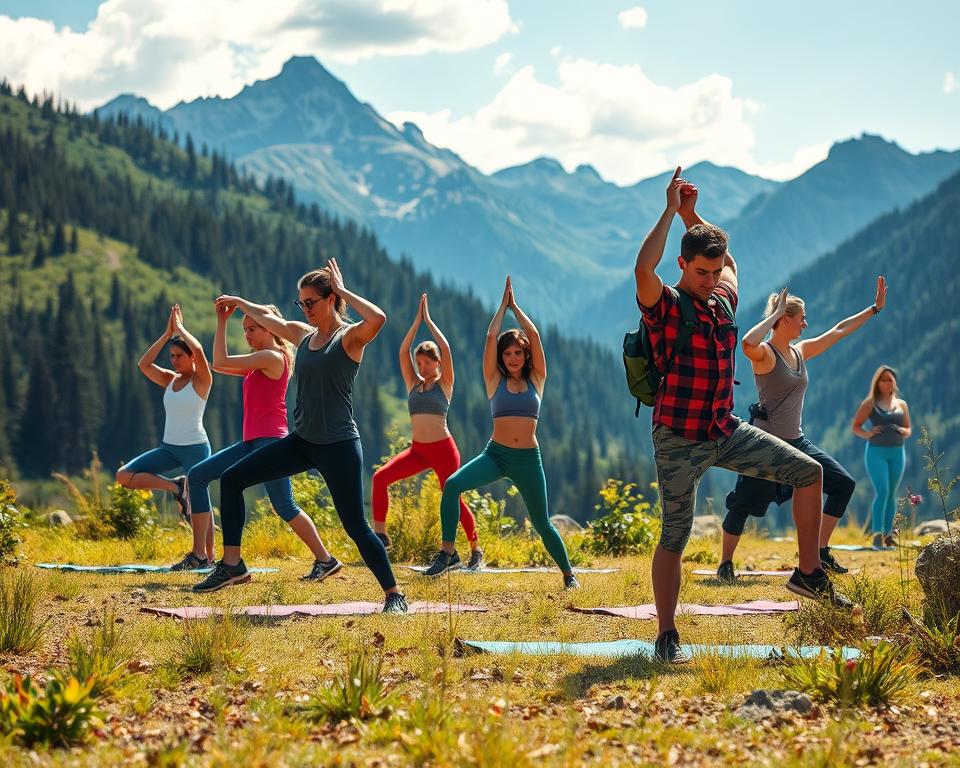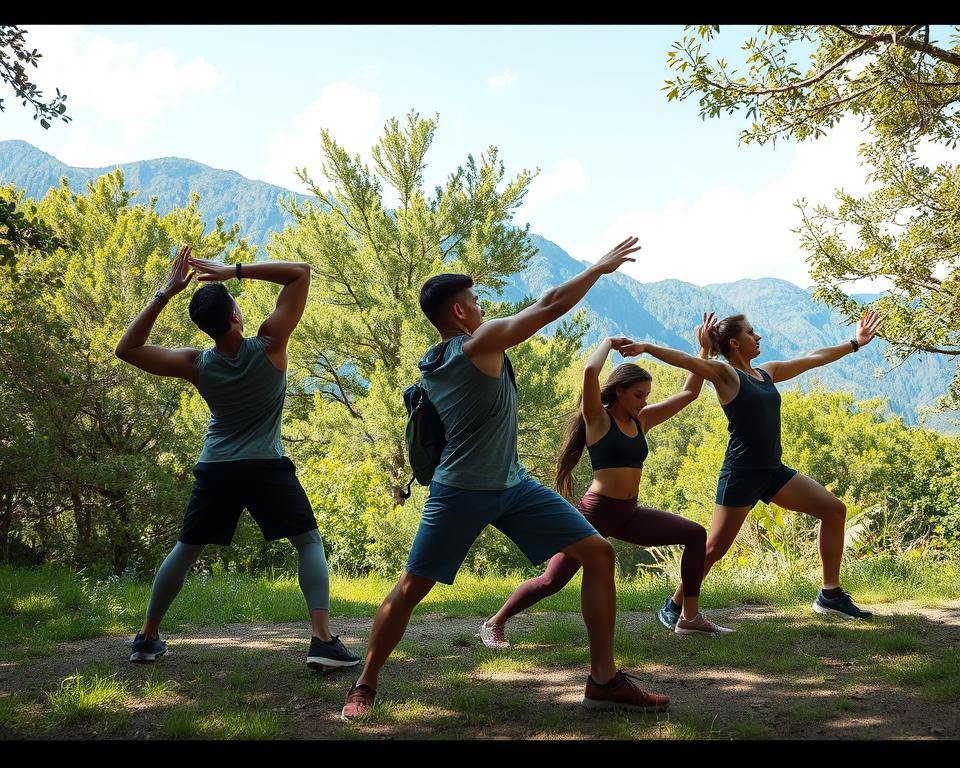Before you hit the trails, stretching is key. It enhances flexibility and preps your joints, helping prevent injuries. A good pre-hike stretching routine warms up your body. Plus, it gets you mentally ready for the journey ahead. It’s a simple, free way to make your hike smoother and more fun.
Studies show that stretching makes your joints move better and lowers the chance of getting hurt. But, warm up before stretching to avoid harm. A quick walk or a light jog is great for getting ready. Now, let’s look at the best hiking stretches to add to your routine.
Why Stretching is Important Before a Long Hike
Stretching before a hike is key to keep your hike fun and safe. Warming up with stretches helps your body perform better. It also prevents injuries while hiking. Let’s look at why stretching is good before a hike.
Benefits of Pre-Hike Stretching
Stretching before your hike has many benefits. It makes you more flexible and improves muscle work. It also increases blood flow, helping avoid serious injuries from minor soreness. Stretching is essential since hiking uses many muscles and builds endurance.
Holding a stretch for the right amount of time is important. For example, a 20-second hamstring stretch or a 30-second calf stretch can ease stiffness.
Types of Stretches for Hikers
There are main types of stretches: dynamic and static. Dynamic stretching uses movements to warm up muscles important for hiking. Static stretches involve holding a position to increase flexibility.
Using foam rollers for myofascial release also helps. It eases muscle tightness and improves mobility for hikers.
Warm-Up Stretches for Hiking
Getting ready to hike means doing a good pre-hike warm-up. This is key for staying safe and having fun. Warm-up stretches help get your joints ready, focusing on your ankles, hips, and upper back. They keep your knees and lower back stable, preventing pain during your hike.
The Importance of Warming Up
Warming up is critical because it gets your body and mind ready for what’s ahead. Skipping a warm-up can leave muscles tight and joints stiff. This increases your chance of getting hurt. It’s smart to do simple stretches that don’t need special gear or a lot of room, perfect for early hikes.
Simple Warm-Up Routines
Just a few easy exercises can greatly improve your hike prep. Check out these three suggested warm-up stretches:
- Knee to Wall Stretch: Perform 2 x 10 reps on each side, which helps ankle flexibility and stability.
- Standing Cat Cow: Do 1 x 10 reps for better spine mobility and upper back flexibility.
- Hip Rotations: Complete 1 x 10 reps on each side for prepared hips.
Also, add shoulder circles and neck exercises to your warm-up. Doing these simple stretches and joint exercises makes your hike better.
Dynamic Stretches to Start Your Hike
Starting a hike without warming up can lead to discomfort or injury. It’s key to prepare with a hiking dynamic warm-up. This warm-up activates your muscles. It ensures your hike is enjoyable and safe.
Dynamic vs. Static Stretching
Dynamic stretching involves movements to warm up your muscles. It targets essential joints like ankles, hips, and mid/upper back. Dynamic stretches improve flexibility and mobility. This is vital for walking on uneven ground. Unlike dynamic stretches, static stretches are often used after hiking for recovery.
Effective Dynamic Stretches
To ready your muscles, include leg swings, arm circles, and lateral lunges in your warm-up. These exercises prepare you for the hike’s physical demands. Follow this quick dynamic warm-up routine:
- Leg Swings: Do them forward and side-to-side, 10 times each side.
- Arm Circles: Start with small circles, then go large. Do 10 forward and backward.
- Lateral Lunges: Stay in each lunge for 2 seconds. Do 10 each side.
- Walking Lunges: Lunge forward, 10 reps per leg.
This warm-up, lasting 5-10 minutes, prepares your muscles and prevents injuries. Make your hike better by doing the routine twice. Rest 1-2 minutes between sets. Adding these exercises ensures you’re ready for your hike.
Best stretches to do before a hike
Before you start your hike, it’s key to do stretches for the muscles and joints you’ll use. Doing these stretches makes your hike more enjoyable.

About 70% of these stretches are for your legs and hips because they’re crucial for hiking. Here are some stretches to add to your prep:
- Calf Stretch: Helps prevent calf tightness and improves how much you can move your ankle.
- Standing Quad Stretch: This easy stretch loosens your quads to stop them from getting sore.
- Hamstring Stretch: Reduces tightness in the back of your legs for a more flexible walk.
- Shoulder Rolls: Relaxing your upper body is important too, especially for carrying your backpack.
- Wrist Stretches: Important if you’re using trekking poles.
Then, 30% of the stretches focus on your upper body to keep things balanced. Meanwhile, 40% are about balance and stability, using something for support. Try to stand tall, pull your belly in, drop your shoulders, and lift your chest. These tips help with 20% of our stretches.
The mix of stretches for one side of your body versus both sides is even, at 50-50. They help with balance and flexibility. Try stretching for 10 to 15 minutes during your hike to boost your energy and prevent injuries.
Yoga is also great for hikers. It helps you hike faster, last longer, and avoid getting hurt. Poses like Standing Cat and Cow, Rag Doll, and Down Dog with Calf and IT Band Stretch are good picks. Also try Standing Pigeon Pose or Figure 4, Cow-Face Stretch, Half Splits, Easy Pose Neck Stretch, and Squat to get fully ready.
In short, these key stretches are great prep for your hike. They get your body ready for the fun yet challenging trails ahead.
Targeting the Ankles and Calves
For hikers, focusing on ankles and calves is key to boosting performance and avoiding harm. Ankle flexibility helps keep balance and dodge sprains on rough paths. Meanwhile, calf stretches minimize muscle strains during quick moves or steep climbs.
The Knee to Wall Stretch
This stretch aims to better ankle movement. It’s great for preventing foot and knee pain related to hiking. Here’s the right way to do it:
- Stand facing a wall with toes about two inches away from it.
- Bend one knee and try to touch it to the wall without lifting your heel off the ground.
- Hold for 10-15 seconds and switch sides.
Doing this stretch regularly will greatly enhance your ankle flexibility. It also cuts down on the chance of getting hurt.
Calf Release with Water Bottle
The calf release with a water bottle is another great move for calf flexibility. It helps ease tightness and tension in your calves. This is key in preventing foot pain while hiking. Here’s how it’s done:
- Sit on the ground with legs extended.
- Place a full water bottle under one calf.
- Gently roll back and forth, focusing on tight spots.
Adding calf release exercises to your routine will make hiking more comfy and enjoyable. It ensures a pain-free journey on any trail.
Can Proper Stretching Help Prevent Muscle Cramps During a Long Hike?
Proper stretching can significantly reduce the likelihood of muscle cramps during long hikes. Incorporating effective strategies to prevent hiking cramps—such as dynamic stretches before you hit the trail and static stretches post-hike—enhances flexibility and prepares your muscles for the strain of extensive walking. Keep your body limber for the best experience.
Focusing on the Hips and Legs
Getting your hips and legs ready is a big deal for hikers, especially for long adventures. Good stretches for the hips and warming up your hamstrings can change your hiking game. They get your body ready for tough paths and help avoid usual pains in the knees and back. Here are two stretches that every hiker needs to do.
The World’s Greatest Stretch
The “World’s Greatest Stretch,” or the low lunge, is super important for moving your hips better. It’s great for the hip flexors, glutes, and hamstrings. Start in a plank, then bring a foot up to your hand and drop your hips. This helps your hips move well, which is key for a smooth hiking step. Stay like this for 30 seconds, but it shouldn’t hurt.
Leg Swing for Hamstrings
Leg swings are perfect for getting your hamstrings ready for action. Lean on a wall, and swing your leg back and forth. This gets your muscles flexible and moving well, which helps when you’re climbing up or down. Do this 10-15 times with each leg, keeping your swings smooth to avoid hurting yourself.
Adding these stretches before your hike can make a big difference in how well you do. You’ll feel better during your hike and be more ready for tough trails. Stretching well before you start is a smart way to enjoy hiking without getting hurt.

